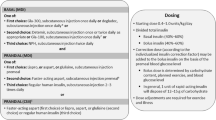Abstract
Rapid gastric emptying and exaggerated plasma concentrations of the insulinotropic hormone GLP-1 precede reactive hypoglycemia after oral glucose in gastrectomy patients. We suspected that the plasma volume drop associated with rapid gastric emptying (early dumping) would be accompanied by elevated plasma concentrations of norepinephrine. In order to study any relationship between postprandial norepinephrine, the enteroinsular axis, and plasma glucose, twelve patients with dumping syndrome and nine controls were studied. The plasma concentrations of norepinephrine, GLP-1, GIP, glucagon, insulin, and glucose were measured following a 1.5 g/kg lean body mass glucose meal. The early (0–30 min) integrated norepinephrine concentration was significantly higher in dumpers (22.1 ± 3.8 nmol/ml/min) compared to controls (14.7 ± 3.1 nmol/ml/min; P < 0.001) and correlated closely with the postprandial hematocrit increment (r = 0.71; P < 0.05). Early immunoreactivities of GLP-1, GIP, and glucagon peaked 30 min after glucose ingestion and were significantly higher in dumpers. Insulin peaked after 60 min and correlated with early GLP-1. In 11 of the patients glucose fell below baseline after a median interval of 120 min. Glucose at 120 min, when most of the nadirs occurred was lowest in patients with high early GLP-1 concentrations (r = 0.78; P < 0.001). Gel filtration chromatography of the dumpers' plasma revealed that pancreatic glucagon was detectable at time 0 and after 20 min, but not after 120 min. It is concluded that in dumpers pancreatic glucagon is augmented in the early postprandial period, probably through stimulation by catecholamines. At 120 min, when most of the hypoglycemias are encountered, pancreatic glucagon is no longer detectable, probably through inhibition by GLP-1.
Similar content being viewed by others
REFERENCES
Wapnick S, Jones JJ: Changes in glucose tolerance and serum insulin following partial gasrectomy and intestinal resection. Gut 13: 871–873, 1972
Lauritsen KB, Frederiksen HJ, Uhrenholdt A, Holst JJ: The correlation between gastric emptying time and the response of GIP and enteroglucagon to oral glucose in duodenal ulcer patients. Scand J Gastroenterol 17: 513–516, 1982
Kreymann B. Ghatei MA, Williams G, Bloom SR: Glucagonlike peptide-1 (7-36): A physiological incretin in man. Lancet 2: 1300–1305, 1987
Miholic J, Ørskov C. Holst JJ, Kotzerke J, Meyer HJ: Emptying of the gastric substitute, glucagon-like peptide-1 (GLP-1), and reactive hypoglycemia after total gastrectomy. Dig Dis Sci 36: 1361–1370, 1991
Miholic J, Ørskov C, Holst JJ, Kotzerke. Pichlmayr R: Postprandial release of glucagon-like peptide-1, pancreatic glucagon, and insulin after esophageal resection. Digestion 54:73–78, 1993
Andreasen JJ, Ørskov C, Holst JJ: Secretion of glucagon-like peptide-1 and reactive hypoglycemia after partial gastrectomy. Digestion 55:221–228, 1994
Naito H, Sasaki I, Matsuno S: Surgical aspect of enteroinsular axis after gastrointestinal surgery with reference to incretin secretion. Pancreas 16: 370–378, 1998
Hertz AF: The cause and treatment of certain unfavorable after-effects of gastroenterostomy. Ann Surg 58: 466–172, 1913
Pokora J, Schabowski J: Five-hour urinary adrenaline and noradrenaline excretion in patients with dumping syndrome after 50 g glucose load. Polskie Arch Med Wewnetrz 60: 355–359, 1978
Shemerdiak WP, Abramson EC, Schlesinger PK, Werner PL: Catecholamines in the early dumping syndrome. Clin Chem 28: 722–723, 1982
Sigstad H: A clinical diagnostic index in the diagnisis of the dumping syndrome. Acta Med Scand 188: 479–486, 1970
Miholic J, Reilmann L, Meyer HJ, KÖrber H, Kotzerke J, Hecker H: Extracellular space, blood volume, and the early dumping syndrome after total gastrectomy. Gastroenterology 99: 923–929, 1990
Lukaski HC, Bolonchuk WW, Hall CB: Validation of tetrapolar bioelectrical impedance method to assess human body composition. J Appl Physiol 60: 1327–1332, 1986
Krarup T, Madsbad S, Moody AJ: Diminished gastric inhibitory polypeptide (GIP) response to a meal in newly diagnosed type I (insulin dependent) diabetics. J Clin Endocrinol Metab 56: 1306–1312, 1983
Holst JJ: Evidence that peak II GLI or enteroglucagon is identical to the C-terminal sequence (residues 33-69) of glicentin. Biochem J 207: 381–388, 1982
Ørskov C, Rabenhøj L, Kofod H, Wettergren A, Holst JJ: Tissue and plasma concentrations of amidated and glycineextended glucagon-like peptide-1 (GLP-1) in man. Diabetes 43: 535–539, 1994
Holst JJ: Molecular heterogeneity of glucagon in normal subjects and in patients with glucagon-producing tumors. Diabetologia 24: 359–365, 1983
Holst JJ, Pedersen JH, Baldissera F, Stadil F: Circulating glucagon after total pancreatectomy in man. Diabetologia 25: 396–399, 1983
Carvajal SH, Mulvihill SJ: Postgastrectomy syndromes: Dumping and diarrhea. Gastroenterol Clin North Am 23: 261–279, 1994
Peddie GH, Jordan GL, DeBakey ME: Further studies on the pathogenesis of the postgastrectomy syndrome. Ann Surg 146: 892–898, 1957
Roberts KE, Randall HT, Farr HW, Kidwell APP, McNeer GP, Pack GT: Cardiovascular and blood volume alterations resulting from intrajejunal administration of hypertonic solutions to gastrectomized patients: the relationship of these changes to the dumping syndrome. Ann Surg 140: 631–640, 1954
Lawaetz O, Blackburn AM, Bloom SR, Aritas Y, Ralphs DNL: Gut hormone profile and gastric emptying in the dumping syndrome. Scand J Gastroenterol 18:73–80, 1983
Schattenmann G, Ebert R, Siewert R, Creutzteldt W: Different response of gastric inhibitory polypeptide to glucose and fat from duodenum and jejunum. Scand J Gastroenterol 19: 260–266, 1984
Cherrington AD, Liljenquist JE: Role of glucagon in regulating glucose production in vivo. In Glucagon. Physiology, Pathophysiology and Morpology of the Pancreatic A-Cells. RH Unger, L Orci (eds). Amsterdam, Elsevier, 1981, pp 221–254
Nauck MA, Siemsgluūss J, Ørskov C, Holst JJ. Release of glucagon-like peptide 1 (GLP-1fi [7-36 amide]), Gastric inhibitory polypeptide (GIP) and insulin in response to oral glucose after upper and lower intestinal resections. Z Gastroenterol 34:159–166, 1996
Toft-Nielsen M, Madsbad S, Holst JJ: Exaggerated secretion of glucagon-like peptide-1 (GLP-1) could cause reactive hypoglycemia. Diabetologia 41: 1180–1186, 1998 DUMPING SYNDROME 1923 Digestive Diseases and Sciences, Vol. 46, No. 9 (September 2001)
Author information
Authors and Affiliations
Rights and permissions
About this article
Cite this article
Gebhard, B., Holst, J., Biegelmayer, C. et al. Postprandial GLP-1, Norepinephrine, and Reactive Hypoglycemia in Dumping Syndrome. Dig Dis Sci 46, 1915–1923 (2001). https://doi.org/10.1023/A:1010635131228
Issue Date:
DOI: https://doi.org/10.1023/A:1010635131228




